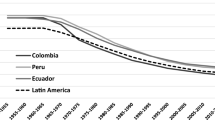Abstract
This study uses data from the young women's and new youth cohort of the National Longitudinal Surveys of Youth Labor Market Experience to examine the extent to which socioeconomic background factors and race have changed in their ability to predict a first birth before age 19 between 1968 and 1980 for women aged nineteen to twenty-three. The authors find little support for their hypothesis that the increasing availability of contraception and abortion for young women from all social classes reduces the traditionally strong inverse association between social class and early childbearing. There is evidence that, even after controlling for changes in socioeconomic background factors, black young women are significantly more likely than their white counterparts to bear children before age 19 in 1980 and the relative gap between races in this regard did not alter perceptively during that period.
Similar content being viewed by others
References
Auletta, K. (1983).The underclass. New York: Vintage Books.
Card, J. (1981). Long term consequences for children of teenage parents.Demography, 18 137–156.
Center for Human Resource Research. (1986).The national longitudinal surveys handbook. Columbus, OH: The Ohio State University.
Cvetkovich, G. et al. (1978). Sex role development and teenage fertility-related behavior.Adolescence 13, 231–236.
Chilman, C. (1978).Adolescent sexuality in a changing American society. Washington, DC: U.S. Government Printing Office.
D'Amico, R., R.J. Haurin, & F.L. Mott. (1983). The effects of mother's employment on adolescent and early outcomes of young men and women. Chapter 6 inChildren of working parents: Experiences and outcomes. Washington, DC: National Academy Press.
Department of Health and Human Services.Monthly vital statistics report, advance report, final natality statistics, 1978. DHHS Publication No. (PHS) 80-1120, 29, Supplement.
Dryfoos, J.G. (1982). Contraceptive use, pregnancy interaction, and pregnancy outcomes Among U.S. women.Family Planning Perspectives, 14 81–94.
Furstenburg, F.Unplanned parenthood: The social consequences of teenage childbearing. New York: The Free Press.
Ford, L. (1981). "Socioeconomic differentials and trends in the timing of births."vital and health statistics, series 23, No. 6. Washington, DC: National Center for Health Statistics, U.S. Department of Health and Human Services.
Fox, G.L. (1977). Sex role attitudes as predictors of contraceptive use among unmarried university students.Sex Roles 3,: 265–283.
Gold, M. (1970).Delinquent behavior in an American city. Belmont, CA: Brooks/Cole.
Hofferth, S. & K.A. Moore. (1979). Early childbearing and later economic well-being."American Sociological Review, 44 784–815.
Jessor, R. & S.L. Jessor. (1977).Problem behavior and psychological development: A longitudinal study of youth. New York: Academic Press.
Jones, E.F. & C.F. Westhoff. (1979) The end of Catholic fertility.Demography 16, 209–218.
Liebow, E. (1967).Talleys corner. 18, Boston: Little, Brown, & Company.
Liebowitz, A., M. Eisen, & W. Chow. (1986). An economic model of teenage pregnancy decision-making.Demography, 23 67–78.
Maxwell, N.L. (1987). Influences on the timing of first childbearing.Contemporary Policy Issues.
McCarthy, J. & E.S. Radish. (1982). Research note: Education and childbearing among teenagers.Family Planning Perspectives, 14 154–55.
Moore, K. & L.J. Waite. (1977). Early childbearing and educational attainment.Family Planning Perspectives, 9 220–225.
Mosher, W.D. & G.E. Hendershot. (1984). Religion and Fertility: A replication.Demography, 21 185–191.
Mott, F.L. (1983).Fertility-related data in the 1982 national longitudinal survey of work experience of youth: An evaluation of data quality and some preliminary analytical results. Prepared for the National Institution of Child Health and Human Development. Columbus, Ohio: Center for Human Resource Research.
Mott, F.L. & N.L. Maxwell. (1981). School age mothers 1968 and 1979.Family Planning Perspectives, 13 287–292.
Mott, F.L. & S.F. Moore. The causes and consequences of marital breakdown. In F.L. Mott et al.,Women, work, and family. Lexington: Lexington Books.
Mott, F.L. & S. Mott. (1984). Prospective life style congruence among American adolescents: Variations in the association between fertility expectations and ideas regarding women's roles.Social forces, 63 184–208.
Mott, F.L. & D. Shapiro. (1978). Pregnancy, motherhood, and work activity. Chapter 5 inWomen, work, and family. Lexington: D.C. Heath and Company.
National Research Council. (1987). Panel on adolescent pregnancy and childbirth.Risking the future. Washington, DC: National Academy Press.
Pindyk, R.S. & D.L. Rubinfeld. (1976).Econometric models and economic forecasts. New York: McGraw-Hill.
Rindfuss, R. & J.A. Sweet. (1977). Chapter 3 inPostwar fertility trends and differentials in the United States. New York: Academic Press.
Ross, H.L. & I. Sawhill. (1975). Chapter 8 inTime of transition. Washington, DC: The Urban Institute.
Shaw, L. & A. Statham. (1982). Fertility expectations and the changing roles of women. Chapter 3 inThe employment revolution, F.L. Mott, editor. Cambridge, MA: The MIT Press.
Studer, M. & A. Thornton. (1987). Adolescent religiosity and contraceptive use.Journal of Marriage and the Family, 49 117–128.
Sweet, J.A.Women in the labor force. (1973). New York: Seminar Press.
Trussell, J.T. (1976). Economic consequences of teenage childbearing.Family Planning Perspectives, 8 184–190.
U.S. Bureau of the Census. Current Population Reports, Series P-60, No. 133.Characteristics of the population below the poverty level, 1980. Washington, DC: U.S. Government Printing Office.
Westhoff, C.F. & N.B. Ryder. (1977).The contraceptive revolution. Princeton: Princeton University Press.
Zelnick, M., J.F. Kantner, & K. Ford. (1981).Sex and pregnancy in adolescence. Beverly Hills, CA: Logo Publications.
Author information
Authors and Affiliations
Additional information
Prepared for presentation at the Population Association of America meetings, April/May 1987. The authors wish to thank Ronald D'Amico and Susan H. Mott for their helpful comments. This report was partially prepared under a contract with the U.S. Department of Labor with funds provided through an interagency agreement with the National Institute of Child Health and Human Development. Interpretations or viewpoints in this document do not necessarily represent the official position or policy of the Department of Labor or the NICHD.
Rights and permissions
About this article
Cite this article
Maxwell, N.L., Mott, F.L. Trends in the determinants of early childbearing. Popul Environ 9, 59–73 (1987). https://doi.org/10.1007/BF01258272
Issue Date:
DOI: https://doi.org/10.1007/BF01258272




